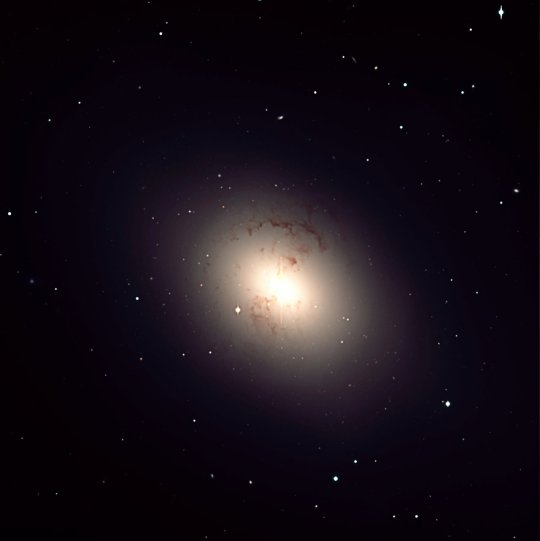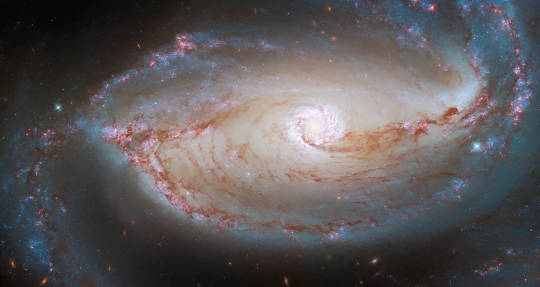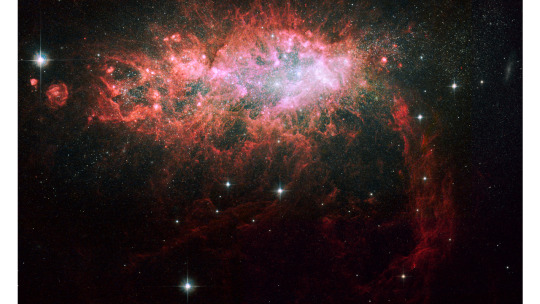#NGC 1596
Explore tagged Tumblr posts
Text
Galaxy Classifications
Because space is a special interest of mine (I mean, I’m the astronomer of the collective for a reason), I thought I’d spread some knowledge. So, today we’re going to be discussing galaxy classifications, what makes each unique, and I’ll be showing some examples of each.
First of all, there are three main types of galaxies; Spiral (with barred spiral being lumped in), Elliptical, and Irregular. We’ll talk about the Elliptical first.
Class- Elliptical
An elliptical galaxy is a galaxy that takes on a stretched out circle-like appearance, like an ellipse, hence the name. It’s unclear how common elliptical galaxies are, since they contain far less gas and dust than spirals, which are known for being hotbeds of star formation, and therefore fewer new (and brighter) stars are born in these galaxies. The majority of stars are much older and give off dimmer red light, and as a result, it’s tougher to see elliptical galaxies.
Example:

This is NGC 1316, an elliptical galaxy in the Fornax star cluster. Note how dim the light is around everything but its center, and how little dust there is, save for the black streaks around the inner ‘disk’ nearest the core. Given these characteristics, it becomes pretty clear why it takes longer for us to find them.
Sometimes we find elliptical galaxies that came about as a result of two spirals crashing into each other over billions of years.
Example:

Notice the two different cores of what used to be spiral galaxies. These are NGC 2292 and 2293, two spiral galaxies that collided in Canis Major, and flung their stars, gas and dust outward (note the ring of dust on the outer edge of the galaxy) and created an elliptical galaxy.
Class- Spiral Galaxy
Next, let’s talk about spiral galaxies. Everyone knows what a spiral looks like. It’s a pinwheel, with several self-perpetuating, long lived spinning arms and contains plenty of newborn and young stars, as well as a large enough amount of gas and dust to fuel star birth. Our own Milky Way is a spiral galaxy, as is the well known Andromeda galaxy, which we’re currently on a course to collide with in about 4-5 billion years.
It’s estimated that about 70% of the galaxies closest to us are spirals, and they make up most galaxies we discover. Spirals are known to be star forming factories, responsible for the majority of newborn stars, and therefore shine brighter than other galaxy types with older and dimmer stars.
Example:

This is Messier 81, or M81, a spiral galaxy in Ursa Major and the largest in its group. Note the distinct arms, the copious amounts of space dust and gasses, and the much brighter, much younger stars (as recent as a few million years old) in its arms while its oldest stars remain closer to the center.
At its center is a black hole of about 70 million solar masses, 15 times bigger than our own central black hole, Sagittarius A*. You can actually see this galaxy right now, being that it’s April at the time of posting this, through binoculars. Though, it will only look like a small, dim grey smudge. A small telescope, however, would be able to see its core if you point it in the right place.
Now. Barred spiral galaxies. Simply put, they’re just spiral galaxies that have a central bar shaped arm running through the middle made of stars and tend to look a little more squished than typical spirals.
Example:

This is NGC 1097, a barred spiral galaxy in the Fornax cluster. Note the somewhat almond shaped appearance, the strip of dust and stars running across the galaxy’s center. These bars are actually found in about half of all spiral galaxies, and a recent study headed by Debra and Bruce Elmegreen and Kartik Sheth confirms that the formation of bars is a sign of a galaxy reaching full maturity as the ‘formative years’ come to an end.
Class- Irregular
And finally, we come to irregular galaxies. The oddballs of the universe that don’t look like galaxies at all. They’re called irregular, because they can’t be placed neatly into the Hubble sequence, something Edwin Hubble came up with in 1926 to categorize galaxies. Some feature some structure, like a spiral’s arm, but not enough to place them into the sequence cleanly. Most have no distinct regular shape like spiral or elliptical galaxies, with no trace of a nuclear bulge or spiral arm structure. They’re thought to be deformed spiral or elliptical galaxies, ripped apart by uneven external gravitational forces.
Example:

This is NGC 1569, a dwarf irregular starburst galaxy with constant star formation activity (as denoted by the bright pink near the ‘center’) in Camelopardalis. Note the lack of a nuclear bulge, no distinct shape, and in particular for this one, the unusual amount of star birthing activity. It’s called ‘starburst’ for how fast it puts out stars, at a rate about 10 to the third power greater than a normal galaxy.
This really is just the tip of the iceberg when it comes to exploring galaxies (I didn’t even touch on lenticular galaxies or Seyfert spirals), but I hope this little glance at the universe was informative all the same.
-Astronomer
#information#space aesthetic#modern astronomy#galaxies#spiral galaxy#elliptical galaxy#irregular galaxy#NGC 1316#NGC 2292#NGC 2293#M81#NGC 1097#NGC 1596
72 notes
·
View notes
Link
1596 POLAND DANZIG King Sigismund III ANTIQUE Silver 6 Groszy Coin NGC i87858

To see 1596 POLAND DANZIG King Sigismund III ANTIQUE Silver 6 Groszy Coin NGC i87858 visit: https://www.ebay.com/itm/1596-POLAND-DANZIG-King-Sigismund-III-ANTIQUE-Silver-6-Groszy-Coin-NGC-i87858/233866775352?hash=item36738bcb38:g:u-wAAOSwp3RgCHDF
0 notes